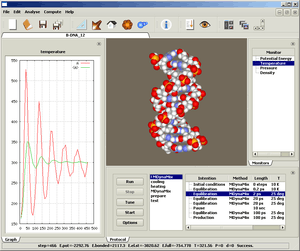MDynaMix
|
DNA simulation on MDynaMix | |
| Original author(s) | Aatto Laaksonen, Alexander Lyubartsev |
|---|---|
| Developer(s) | Stockholm University, Department of Materials and Environmental Chemistry, Division of Physical Chemistry |
| Initial release | 1993 |
| Stable release |
5.2.7
/ 31 January 2015 |
| Development status | Active |
| Written in | Fortran 77-90 |
| Operating system | Unix, Unix-like, Linux, Windows |
| Platform | x86, x86-64, Cray |
| Available in | English |
| Type | Molecular dynamics |
| License | GPL |
| Website |
www |
Molecular Dynamics of Mixtures (MDynaMix) is a computer software package for general purpose molecular dynamics to simulate mixtures of molecules, interacting by AMBER- and CHARMM-like force fields in periodic boundary conditions.[1][2] Algorithms are included for NVE, NVT, NPT, anisotropic NPT ensembles, and Ewald summation to treat electrostatic interactions. The code was written in a mix of Fortran 77 and 90 (with Message Passing Interface (MPI) for parallel execution). The package runs on Unix and Unix-like (Linux) workstations, clusters of workstations, and on Windows in sequential mode.
MDynaMix is developed at the Division of Physical Chemistry, Department of Materials and Environmental Chemistry, Stockholm University, Sweden. It is released as open-source software under a GNU General Public License (GPL).
Programs
- md is the main MDynaMix block
- makemol is a utility which provides help to create files describing molecular structure and the force field
- tranal is a suite of utilities to analyze trajectories
- mdee is a version of the program which implements expanded ensemble method to compute free energy and chemical potential (is not parallelized)
- mge provides a graphical user interface to construct molecular models and monitor dynamics process
Field of application
- Thermodynamic properties of liquids[3]
- Nucleic acid - ions interaction[4]
- Modeling of lipid bilayers[5]
- Polyelectrolytes[6]
- Ionic liquids[7][8]
- X-ray spectra of liquid water[9]
- Force Field development[10][11]
See also
References
- ↑ A.P.Lyubartsev, A.Laaksonen (2000). "MDynaMix - A scalable portable parallel MD simulation package for arbitrary molecular mixtures". Computer Physics Communications. 128 (3): 565–589. doi:10.1016/S0010-4655(99)00529-9.
- ↑ A.P.Lyubartsev, A.Laaksonen (1998). "Parallel molecular dynamics simulations of biomolecular systems". Applied Parallel Computing Large Scale Scientific and Industrial Problems. Lecture Notes in Computer Science. 1541. Heidelberg: Springer Berlin. pp. 296–303. doi:10.1007/BFb0095310. ISBN 978-3-540-65414-8.
- ↑ T. Kuznetsova & B. Kvamme (2002). "Thermodynamic properties and interfacial tension of a model water–carbon dioxide system". Phys. Chem. Chem. Phys. 4 (6): 937–941. doi:10.1039/b108726f.
- ↑ Y. Cheng, N. Korolev & L. Nordenskiöld (2006). "Similarities and differences in interaction of K+ and Na+ with condensed ordered DNA. A molecular dynamics computer simulation study". Nucleic Acids Research. 34 (2): 686–696. doi:10.1093/nar/gkj434. PMC 1356527
 . PMID 16449204.
. PMID 16449204. - ↑ C.-J. Högberg; A.M.Nikitin & A.P. Lyubartsev (2008). "Modification of the CHARMM force field for DMPC lipid bilayer". Journal of Computational Chemistry. 29 (14): 2359–2369. doi:10.1002/jcc.20974. PMID 18512235.
- ↑ A. Vishnyakov & A.V. Neimark (2008). "Specifics of solvation of sulfonated polyelectrolytes in water, dimethylmethylphosphonate, and their mixture: A molecular simulation study". J. Chem. Phys. 128 (16): 164902. doi:10.1063/1.2899327. PMID 18447495.
- ↑ G. Raabe & J. Köhler (2008). "Thermodynamical and structural properties of imidazolium based ionic liquids from molecular simulation". J. Chem. Phys. 128 (15): 154509. doi:10.1063/1.2907332. PMID 18433237.
- ↑ X. Wu, Z. Liu, S. Huang and W. Wang (2005). "Molecular dynamics simulation of room-temperature ionic liquid mixture of [bmim][BF4] and acetonitrile by a refined force field". Phys. Chem. Chem. Phys. 7 (14): 2771–2779. doi:10.1039/b504681p. PMID 16189592.
- ↑ R.L.C. Wang, H.J. Kreuzer & M. Grunze (2006). "Theoretical modeling and interpretation of X-ray absorption spectra of liquid water". Phys. Chem. Chem. Phys. 8 (41): 4744–4751. doi:10.1039/b607093k. PMID 17043717.
- ↑ A.M. Nikitin & A.P. Lyubartsev (2007). "A new six-site acetonitrile model for simulations of liquid acetonitril and its aqueous mixture". J. Comp. Chem. 28 (12): 2020–2026. doi:10.1002/jcc.20721. PMID 17450554.
- ↑ E.S. Böesa; E. Bernardia; H. Stassena; P.F.B. Gonçalves (2008). "Solvation of monovalent anions in formamide and methanol: Parameterization of the IEF-PCM model". Chemical Physics. 344: 101–113. doi:10.1016/j.chemphys.2007.12.006.
